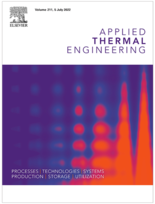
Residential solar air conditioning: energy and exergy analyses of an ammonia–water absorption cooling system.
Author(s) : AMAN J., TING D. S. K., HENSHAW P.
Type of article: Article
Summary
Large scale heat-driven absorption cooling systems are available in the marketplace for industrial applications but the concept of a solar driven absorption chiller for air-conditioning applications is relatively new. Absorption chillers have a lower efficiency than compression refrigeration systems, when used for small scale applications and this restrains the absorption cooling system from air conditioning applications in residential buildings. The potential of a solar driven ammonia–water absorption chiller for residential air conditioning application is discussed and analyzed in this paper. A thermodynamic model has been developed based on a 10 kW air cooled ammonia–water absorption chiller driven by solar thermal energy. Both energy and exergy analyses have been conducted to evaluate the performance of this residential scale cooling system. The analyses uncovered that the absorber is where the most exergy loss occurs (63%) followed by the generator (13%) and the condenser (11%). Furthermore, the exergy loss of the condenser and absorber greatly increase with temperature, the generator less so, and the exergy loss in the evaporator is the least sensitive to increasing temperature.
Details
- Original title: Residential solar air conditioning: energy and exergy analyses of an ammonia–water absorption cooling system.
- Record ID : 30010272
- Languages: English
- Source: Applied Thermal Engineering - vol. 62 - n. 2
- Publication date: 2014/01
- DOI: http://dx.doi.org/10.1016/j.applthermaleng.2013.10.006
Links
See other articles in this issue (15)
See the source
Indexing
-
THEORETICAL ANALYSIS OF AMMONIA-WATER ABSORPTIO...
- Author(s) : KAUSHIK S. C., BHARDWAJ S. C.
- Date : 1982/07
- Languages : English
- Source: Int. J. Energy Res. - vol. 6 - n. 3
View record
-
CONSIDERATION OF ABSORPTION REFRIGERATION SYSTEMS.
- Author(s) : YAMASAKI H., SAKO M., CHIBA T.
- Date : 1985
- Languages : Japanese
- Source: Transaction of the Society of Heating, Air-conditioning and Sanitary Engineers of Japan - n. 28
View record
-
Simulation of solar air conditioning systems in...
- Author(s) : VIÑAS E., BEST R., LUGO S.
- Date : 2016/03/25
- Languages : English
- Source: Applied Thermal Engineering - vol. 97
View record
-
COMPUTERISED DESIGN AND ECONOMIC EVALUATION OF ...
- Author(s) : SHIRAN Y.
- Date : 1982
- Languages : English
View record
-
SIMULATION OF A SOLAR DRIVEN AQUA-AMMONIA ABSOR...
- Author(s) : ALVARES S. G., TREPP C.
- Date : 1987
- Languages : English
- Source: International Journal of Refrigeration - Revue Internationale du Froid - vol. 10 - n. 1
- Formats : PDF
View record
